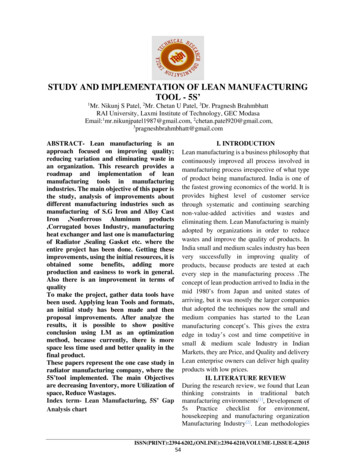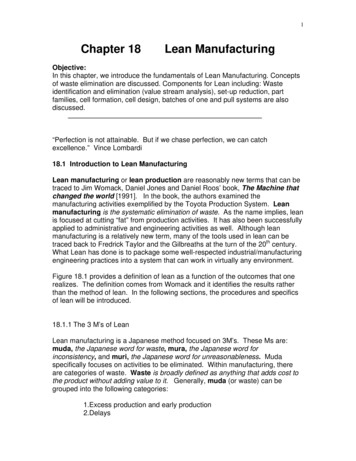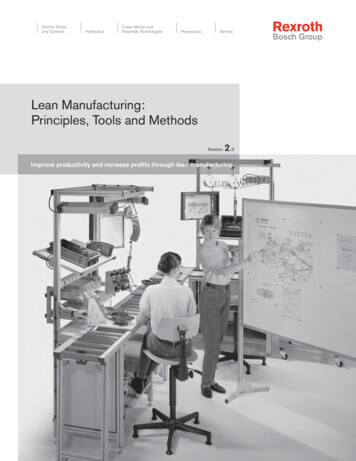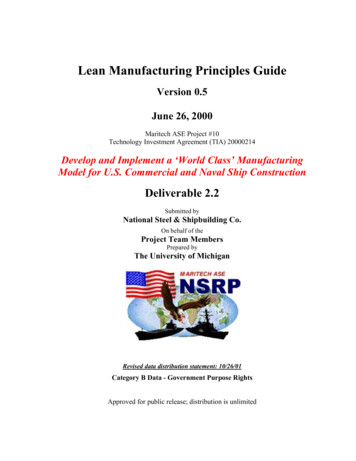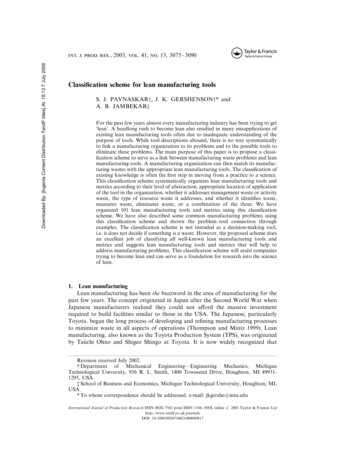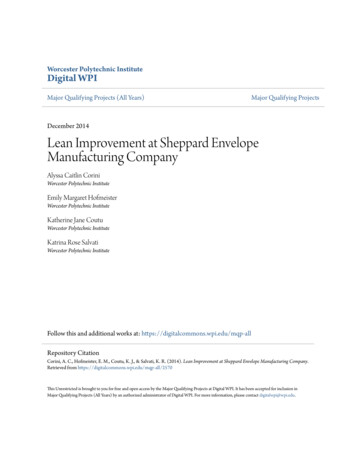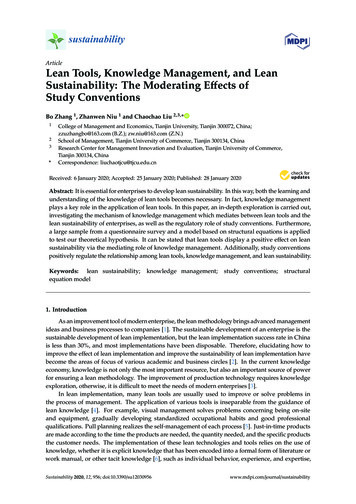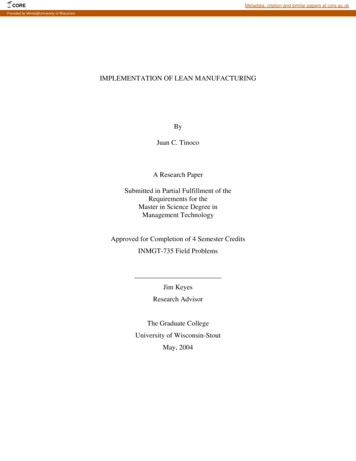
Transcription
COREMetadata, citation and similar papers at core.ac.ukProvided by Minds@University of WisconsinIMPLEMENTATION OF LEAN MANUFACTURINGByJuan C. TinocoA Research PaperSubmitted in Partial Fulfillment of theRequirements for theMaster in Science Degree inManagement TechnologyApproved for Completion of 4 Semester CreditsINMGT-735 Field ProblemsJim KeyesResearch AdvisorThe Graduate CollegeUniversity of Wisconsin-StoutMay, 2004
iiThe Graduate SchoolUniversity of Wisconsin-StoutMenomonie, WI 54751ABSTRACTTinoco(Writer) (Last Name)JuanC.(First)(Initial)Implementation of Lean Manufacturing(Title)Management TechnologyJim KeyesMay, 200465(Graduate Major)(Research Advisor)(Month/Year)(No. of Pages)Publication Manual of the American Psychological Association(Name of Style Manual Used in this Study)Lean manufacturing refers to a manufacturing improvement process based on thefundamental goal of Toyota production system (TPS) in order to minimize or eliminate wastewhile maximizing production flow (Tapping, 2002). Many manufacturing organizations realizethe importance of practicing lean techniques. However, few organizations apply lean techniqueswith the necessary knowledge and proven tools to achieve it.A value stream includes all the operations and processes to transform raw materials intofinished goods or services, including non-value adding activities. Value stream management is amanagement tool for planning a production process involving lean initiatives through systematicdata capture and analysis (Tapping, 2002). It is a proven process for planning the improvementsthat will allow companies to develop lean practices.The purpose of this study is to develop a value stream map for a manufacturing companyin Minnesota. This particular tool allows the company to document current lead time, inventory
iiilevels and cycle times to determine the ratio of value added to total lead time of the product linebeing analyzed. The first step will be to create a current state map to make a picture of theproduction flow and understand the company’s current cycle times, process communications,and machine equipment capacity. This provides the information needed to produce a future statemap by creating a vision of an ideal value flow, although that will not be done in this study. Thegoal is to identify and eliminate the waste, which is any activity that does not add value to thefinal product, in the production process.In order to collect the information needed to complete the project, the researcher willwork within the production facility. This will enable the researcher to have a first handknowledge of the production flow and to be familiar with the activities being performed at theshop floor. In addition, the researcher will observe and collect information related to productfamilies for the practical mapping and product/process flow from start to finish, calculating takttime from data collected by the host company. The researcher will document cycle times, downtimes, work-in-process inventory (WIP), and material and information flow paths. Thisinformation will enable the researcher to visualize the current state of the process activities bymapping the material and information flow and looking for opportunities to eliminate wastes andto improve the process flow. Based on all the information gathered, the company will utilizethese results as a plan to map the future state and implement lean manufacturing.
ivACKNOWLEDGEMENTSThanks a lot to the following people who providedimmeasurable help during this project:Jim Keyes, my advisor;Lloyd Peterson, at College of Technologies department at UW-Stout;Mike Armbrust and Mark Karnick at XYZ Company at MinnesotaTo my wife, for supporting and loving me,To “Juan Pi”, for being my son and inspiration,To Pedro and Mirian, for being my parents and believing in me,To Mariana, for being my sister and cheering me up,To Francisco and Dora, for being my parents in law and helping me at every moment.To all of you and God, thanks for being there
vTABLE OF CONTENTS pageABSTRACT. iiLIST OF TABLES. viiiLIST OF FIGURES . ixCHAPTER I . 1Statement of the Problem. 2Research Objectives. 2Importance of the Study. 2Limitations of the Study. 3Assumptions of the Study . 3Definition of Terms. 3CHAPTER II. 6Definition of Lean Manufacturing . 6Lean Manufacturing Origins. 7Value-Added versus Non-Value-Added Activities . 8Five Primary Elements for Lean Manufacturing . 9Issues in Lean Manufacturing. 9Types of Wastes. 10Stages of Lean Application. 11Demand Stage . 11Flow Stage . 11Leveling Stage. 12
viLean Manufacturing Tools and Techniques . 12Just-in-Time . 12Kanban Systems . 13Production Smoothing Method . 16Standardization of Operations. 16Autonomation. 17Work Cells. 19Kaizen . 20Definition of Value Stream. 21Value Stream Management. 22Value Stream Mapping . 23Summary . 25CHAPTER III . 26CHAPTER IV . 30Material Flow. 30Information Flow . 31Process Attributes . 32Daily Customer Requirements . 32Takt Time . 32Availability. 32Individual Metrics. 33Number of Operators . 33Cycle Time . 34
viiChangeover Time . 34Available Uptime . 35Work-in-Process (WIP) Inventory . 35Metrics for the Entire Value Stream . 38Cumulative Available Uptime . 38Total Value Stream WIP Inventory . 38Total Value Stream Days of WIP . 38Total Product Cycle Time . 38Lead Time. 38Conclusion . 39CHAPTER V . 41Observations . 41Recommendations. 42References. 46Appendix A: Details of a Resonator . 47Appendix B: Quantity of Parts per Resonator . 48Appendix C: Sequence of Operations and Work center per Part. 50Appendix D: Data Collected Day 1 . 51Appendix E: Data Collected Day 2. 54Appendix F: Data Collected Day 3. 57Appendix G: Data Collected Day 4 . 60Appendix H: Individual Metrics Collected. 63Appendix I: Lead Time. 65
viiiLIST OF TABLESTable 1: Family of ATV Resonators Selected to Develop a Value Stream Map 27Table 2: Metrics for Each Process .34Table 3: WIP Inventory Between the Processes (in terms of Resonators) .36Table 4: WIP Inventory Between the Processes (in terms of Parts) 37
ixLIST OF FIGURESFigure 1: Withdrawal Kanban 14Figure 2: Production Ordering Kanban .15Figure 3: Triangular Kanban .15Figure 4: Material Requisition Kanban .16Figure 5: Value Stream Mapping Symbols 23Figure 6: Example of a Value Stream Map .25Figure 7: Value Stream Map for Resonators .40
CHAPTER IINTRODUCTIONManufacturing operations are continually striving to increase productivity and output oftheir operations. Their goal is to satisfy the customer with the exact product, quality, quantity,and price in the shortest amount of time.Lean manufacturing is more than a cost reduction program or a problem solving approach(Tapping, 2002). The main idea is that an efficient production can be achieved by acomprehensive approach to minimize wastes. This means eliminating excess production andinventory, redundant movement of material, waiting and delays, over processing, excess workermotion, and the need for rework and corrections.Part of lean manufacturing is reviewing operations for those components, processes orproducts that add cost rather than value (Tapping, 2002). Each step of the manufacturing processis monitored to determine if it adds value to the product. If it does not add value, the processcould be delegated to a subcontractor or outsourcing company in order to focus the staff onvalue-added operations of its core business.A value stream is the set of processes required to transform raw materials into finishedgoods that customers value (Womack & Jones, 1996). In this study, a value stream map will bedeveloped for a manufacturing company in Minnesota. Creating a value stream map will allowthe company to document current production lead time, inventory levels, and cycle times in orderto determine the ratio of value-added to total lead time of the product family being analyzed,creating a vision of an ideal value flow. The goal is to identify and eliminate the wastes in theproduction process. The company will use these results in order to map the future state andimplement lean manufacturing.
2Statement of the ProblemThe purpose of this study is to develop a value stream map for XYZ manufacturingcompany in Minnesota and identify wastes and make recommendations for improvement. It ishoped that the company uses the value stream map for the future implementation of leanmanufacturing, in order to increase productivity and improve the quality of goods produced bythe company, while at the same time reducing costs, total lead time, human effort, and inventorylevels.Research Objectives1. Work within the production facility to have a first hand knowledge of the productionflow and to be familiar with the activities being performed in the shop floor.2. Select which value stream to target for the practical mapping.3. Observe and collect information related to product/process flow from raw material tofinished goods for the value stream selected.4. Determine the current state of the process activities by mapping the material and theinformation flow.5. Calculate lean metrics from the value stream map.6. Look at the current state map for opportunities to eliminate wastes and improve theprocess flow.Importance of the StudyThe value stream map that will result from this study could reduce costs, improve leadtime, increase productivity, and improve quality of the products produced by XYZ company inMinnesota. The impact of not doing the study could be inefficiency and working with an excess
3amount of work-in-process inventory which will result in delays on delivery orders, higheroperating cost, loss of customers, and less sales revenue.Limitations of the StudyThe limitations of the project were that1. The results of this study are limited to XYZ manufacturing company.2. The company defined the value stream to be targeted for improvements.3. The results will be based on data collected from the production activities performedalong the value stream selected.4. The study includes only the development of the current state map for a value streamselected and recommends ways to improve the process.5. The development of the future state map will not be included in this study.6. The study does not explain how to implement lean manufacturing.Assumptions of the StudyIt is assumed that by designing a map of the present state of the value stream selectedwith the necessary technical information and references to develop a future state map, XYZmanufacturing company in Minnesota will have the capacity to develop a future map in aneffective way to implement lean manufacturing, in order to increase the productivity and output,as well as to reduce costs, inventory, and time. It is also assumed that all of the work centersinvolved in the study were working only with the selected value stream.Definition of TermsAvailable Production Time: Determined by taking the shift time and subtracting regular planneddowntime events such as breaks.
4Available Operating Time: Determined by taking the available production time and subtractingchangeover time.Batch Size: A technique used to run a determined quantity of parts at one operation prior tomoving them to the next operations.Changeover Time: The time that an operator spends at a work center switching the productiontools in order to change from one product type to another.Downtimes: Those are considered break times. Downtimes are regular planned times and usuallyinvolve unpaid lunch and paid breaks. During a downtime the production does not run.Electronic Data Interchangeable: It is a tool that allows companies to process the purchasingorder electronically.Finished Goods: Refers to parts that already have been manufactured and are in the completedstage waiting to be shipped to the customer.Kaizen: Continual improvement involving everyone within an organization (Ohno, 1998)Kanban: A tool to achieve just-in-time which consists of a card containing all the informationrequired to be done on a product at each stage along its path to completion and which parts areneeded at subsequent processes (Monden, 1993)Lead Time: The time that parts take to be transformed from raw material to finished goods.Lean Metrics: A list of measurements that will help for tracking progress toward the targetsselected for improvements.Material Requirement Planning: It is a tool that helps manage the production process. Basically,it is a plan for the production of the components and purchase of materials needed to make anitem.
5Operating cost: It is all the money that the company spends in order to turn inventory intofinished goods.Operators: Involves those individuals that provide the work hand to perform an operation.Product Family: Refers to all the parts that are produced within the same value stream. All theparts for the product family group have common production processes and same patterndevelopment.Raw Material: Material that has been purchased but not changed in any way.Value Stream: The set of processes, including value-added and non-value-added activitiesrequired to transform raw materials into finished goods that customers value (Womack & Jones,1996).Work-in-Process: Any product in the production process than began as raw material, but is not afinished good yet.
CHAPTER IIREVIEW OF LITERATUREThis chapter compiles and organizes information about value streams and leanmanufacturing that will aid the reader in understanding the specifics of the study.Definition of Lean ManufacturingAccording to Womack, Jones, and Roos (1990), the term “lean” represents a system thatutilizes fewer inputs in order to create the same outputs than those created by a traditional massproduction system, while increasing the range of different finished goods for the end customer.The term lean manufacturing is synonymous with different names, such as agile manufacturing,just-in-time manufacturing, synchronous manufacturing, world class manufacturing, andcontinuous flow.Lean manufacturing is an operational strategy oriented toward achieving the shortestpossible cycle time by eliminating waste (Liker, 1997). It is derived from the Toyota productionsystem and its objective is to increase the value-added work by eliminating wastes and reducingunnecessary work. The technique often decreases the time between a customer order andshipment, and it is designed to improve profitability, customer satisfaction, throughput time, andemployee motivation.The benefits of lean manufacturing generally are lower costs, higher quality, and shorterlead times (Liker, 1997). The term lean manufacturing is created to represent less human effortin the company, less manufacturing space, less investment in tools, less inventory in progress,and less engineering hours to develop a new product in less time.
7Lean Manufacturing OriginsAfter World War II, Japanese manufacturers were facing the dilemma of insufficiency ofmaterials, financial problems, and human resources (Ohno, 1988). The problems that theJapanese faced differed from those in America. For many decades America had cut costs byusing the mass production system while producing fewer types of end items while for theJapanese the problem was how to cut costs while producing small numbers of many types of enditems.According to Ohno (1988),Imitating America is not always bad. We have learned a lot from the U. S. automobileempire. America has generated wonderful production management techniques, businessmanagement techniques such as quality control (QC) total quality control (TQC) andindustrial engineering (IE) methods. (p. 3)In the 1940s a German worker could produce three times as much as a Japanese worker,and an American worker could produce three times as much as a German worker (Ohno, 1988).Therefore, the ratio of production between American and Japanese work forces was nine to one.In order to make a move toward improvement, the Japanese leader Toyoda Kiichiro proposed toreduce the gap with America in three years, resulting in the birth of the lean manufacturingpractices.The term lean manufacturing was first used to describe the implementation of what isnow considered to be part of lean manufacturing such as a Kanban or just-in-time (JIT). It beganas a description of procedures used by the Toyota Motor Corporation from 1950 through the1980s (Ohno, 1988). Now lean means much more. The Toyota production system started as partof a strategy to survive developed by Taiichi Ohno, presently vice president of the Toyota, in an
8effort to conserve capital, eliminate waste, reduce inventory, and reduce production times andoperating expenses while increasing quality and production flexibility at the same time. TheToyota production system was proved to be successful and implemented throughout the entirecompany.Toyota opened its first major operation in the United States in 1984 through a jointventure with General Motors in Fremont, CA (Ohno, 1988). Since then, Toyota has madecontinuous progress adapting its production system to a diverse workforce and a geographicallyspread supplier base. The reputation of the company has grown across the world. While mostcompanies have suffered with enormous losses in business cycle decline, Toyota has not lostmoney since 1960. The major contributor to their success has been Toyota production system.The Toyota production system has been created on the practice and evolution of one veryuseful technique that reduces cost and time while challenges every activity in the value stream(Ohno, 1988). It is applying a methodology known as the “Five whys.” By asking why anactivity is performed and then asking why after each response, it is frequently possible to get tothe origin of the problem. Understanding the root cause assists in successful redesign.Value-Added versus Non-Value-Added ActivitiesThe process of transforming raw material into finished goods is the objective of anymanufacturing company (Tapping, 2002). The processes that make that transformation possibleare the result of two different activities: those that add value and those that do not. Value-addedactivities are considered the actions and the process elements that accomplish thosetransformations and add value to the product from the perspective of the customer (e. g., tubing,stamping, welding, painting, etc.). Non-value-added activities are the process elements that do
9not add value to the product from the perspective of the customer such as setting up, waiting formaterials, and moving materials.In the past companies have been focused on the value-added steps (Corner, 2001). Thegoal was to reduce the value-added component of lead time and not pay too much attention to thenon-value-added activities. Today, lean manufacturing strives to improve as much as possible thevalue-added component of lead time, but focus first on reducing the non-value-added componentof lead time.Five Primary Elements for Lean ManufacturingThe five primary elements to consider when implementing lean manufacturing aremanufacturing flow, organization, process control, metrics, and logistics (Feld, 2000). Theseelements represent the variety of aspects needed to sustain a successful lean manufacturingimplementation program. Manufacturing flow addresses physical changes and design standards.Organization identifies people’s roles/functions, training in new ways of working, andcommunication. Process control is directed at monitoring, controlling, stabilizing, and pursuingways to improve the process. Metrics addresses visible results-based performance measures,targeted improvement, and team rewards/recognition. Logistics provide the definition foroperating rules and mechanisms for planning and controlling the flow of material.Issues in Lean ManufacturingLean manufacturing is in direct opposition with traditional manufacturing approachescharacterized by use of economic order quantities, high capacity utilization, and high inventory(Feld, 2000). In changing from a traditional environment to one of lean production, culturalissues will emerge quickly, as well as resistance to change. Implementing lean manufacturingtechniques will change the organizational culture because everyone needs to be more involved
10and accountable and people may be laid off. A fast managing change program is needed toaccompany the effort. A slow approach generally does not work or achieve significant results.Lean manufacturing is not a magical solution (Feld, 2000). It involves a change inleadership that requires considerable communication, coordination, and organization whichresults in a change in the company’s culture. Just implementing one lean technique such as aKanban system will not result in lean implementation. Positive employee reaction to leanmanufacturing is essential to success, but does not always occur since becoming lean improvesproductivity and can reduce the number of workers needed. Laying people off and asking theremaining employees to become more involved may not work.Feld (2000) stated that in order to create a lean manufacturing environment, theorganization needs to be aware of where it is at that point. They must know why they need tochange and why change is important. It is necessary to provide the answers to these questions toemployees so they become more engaged in the process. “Motivation, tenacity, leadership, anddirection all play roles in the successful deployment of a lean program” (p. 7). Feld also statedthat roles within the team and the way in which team members interact with one another areimportant. All members must understand their roles and why they were selected for theirassignment.Types of WastesAccording to Tapping (2002) “the ultimate lean target is the total elimination of waste.Waste, or muda, is anything that adds cost to the product without adding value” (p. 41).Wastes can be classified into seven categories (Tapping, 2002):1. Waste of overproducing: Producing components that are neither intended for stocknor planned for sale immediately.
112. Waste of waiting: Refers to the idle time between operations.3. Waste of transport: Moving material more than necessary.4. Waste of processing: Doing more to the product than necessary and the customer iswilling to pay.5. Waste of inventory: Excess of stock from raw materials to finished goods.6. Waste of motion: Any motion that is not necessary to the completion of an operation.7. Waste of defects and spoilage: Defective parts that are produced and need to bereworked.Stages of Lean ApplicationDemand StageThis stage refers to understanding the customer demand and
Lean manufacturing refers to a manufacturing improvement process based on the fundamental goal of Toyota production system (TPS) in order to minimize or eliminate waste while maximizing production flow (Tapping, 2002). Many manufacturing organizations realize the i
